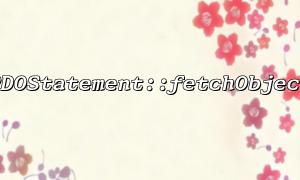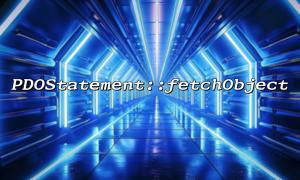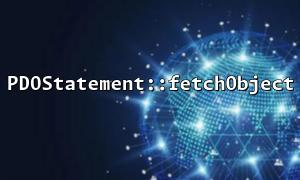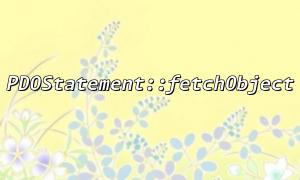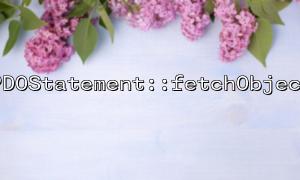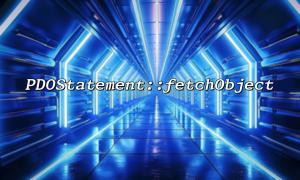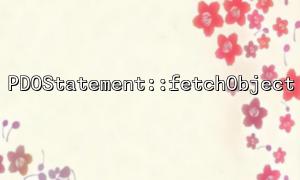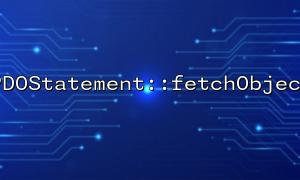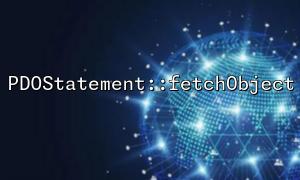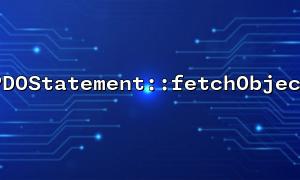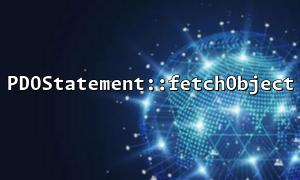In PHP, PDO (PHP Data Objects) is an abstraction layer for database connections and operations, which provides us with a unified way to operate different types of databases. PDOStatement::fetchObject is a method provided by PDO that can return query result sets as objects. This method is very convenient for further processing and operation of data, especially when we need to obtain multi-dimensional array data, fetchObject can also provide a flexible solution.
In this article, we will explore how to use PDOStatement::fetchObject to flexibly obtain and process multidimensional array data, helping you improve the efficiency of data query and processing.
First, let's take a look at the basic usage of PDOStatement::fetchObject . Suppose we have created a PDO instance and executed a query SQL statement:
<?php
// create PDO Example
$pdo = new PDO("mysql:host=localhost;dbname=testdb", "username", "password");
// implement SQL Query
$stmt = $pdo->query("SELECT * FROM users");
// 获取Query结果,Returns an object
$user = $stmt->fetchObject();
echo $user->name; // Output user name
?>
In the above code, the fetchObject method converts the first line of the query result set into an object and returns. The data of each column will appear as an object's attribute.
If the query result has multiple rows of data, we need to get all the records, not just the first row. In this case, we can do this in combination with fetchObject and fetchAll methods:
<?php
// implement SQL Query
$stmt = $pdo->query("SELECT * FROM users");
// Get all data,Return an array of objects
$users = $stmt->fetchAll(PDO::FETCH_OBJ);
// Iterate over and output the names of all users
foreach ($users as $user) {
echo $user->name . "<br>";
}
?>
In this example, fetchAll(PDO::FETCH_OBJ) returns all the query results and converts each row of data into objects and stores them in an array. Next, we iterate through this array and access the properties of each object.
Sometimes, a simple array of objects may not be enough to meet our needs, especially when the data structure is complex, we may want to process the query results into the form of a multidimensional array. To achieve this, we can use PDOStatement::fetchObject and some PHP array manipulation functions to handle data flexibly.
Suppose we have the following table structure, where there is a one-to-many relationship between the users table and the orders table (one user can have multiple orders):
-- User table
CREATE TABLE users (
id INT PRIMARY KEY,
name VARCHAR(255)
);
-- Order table
CREATE TABLE orders (
id INT PRIMARY KEY,
user_id INT,
order_number VARCHAR(255),
amount DECIMAL(10, 2)
);
We want to query the data of each user and all of their orders to generate a multi-dimensional array. In this case, fetchObject can help us process each user and its corresponding order data line by line and organize it into a multi-dimensional array structure:
<?php
// Query用户及其订单
$stmt = $pdo->query("
SELECT users.id AS user_id, users.name AS user_name, orders.order_number, orders.amount
FROM users
LEFT JOIN orders ON users.id = orders.user_id
");
// Result storage array
$usersOrders = [];
// 遍历Query结果并构建多维数组
while ($user = $stmt->fetchObject()) {
// If the user has not appeared in the array,Initialize the user
if (!isset($usersOrders[$user->user_id])) {
$usersOrders[$user->user_id] = [
'user_name' => $user->user_name,
'orders' => []
];
}
// Add orders for users
$usersOrders[$user->user_id]['orders'][] = [
'order_number' => $user->order_number,
'amount' => $user->amount
];
}
// Output multi-dimensional array
echo "<pre>";
print_r($usersOrders);
echo "</pre>";
?>
In this example, we first query the data for each user and their order. Then, the data of each row is obtained through fetchObject and gradually organize it into a multi-dimensional array. Finally, the structure of the $usersOrders array is roughly as follows:
Array
(
[1] => Array
(
[user_name] => John Doe
[orders] => Array
(
[0] => Array
(
[order_number] => A123
[amount] => 100.00
)
[1] => Array
(
[order_number] => B456
[amount] => 150.00
)
)
)
[2] => Array
(
[user_name] => Jane Smith
[orders] => Array
(
[0] => Array
(
[order_number] => C789
[amount] => 200.00
)
)
)
)
This approach is ideal for processing data similar to one-to-many relationships, organizing information about users and all of their orders into a conveniently accessible multi-dimensional array.
If we need to further encapsulate the data and add more business logic, we can map the query results to instances of the custom class. For example, suppose we have a User class and Order class, and we want to map the results of the query directly into the objects of these classes.
<?php
// User class
class User {
public $id;
public $name;
public $orders = [];
public function __construct($id, $name) {
$this->id = $id;
$this->name = $name;
}
}
// Order category
class Order {
public $order_number;
public $amount;
public function __construct($order_number, $amount) {
$this->order_number = $order_number;
$this->amount = $amount;
}
}
// Query数据
$stmt = $pdo->query("
SELECT users.id AS user_id, users.name AS user_name, orders.order_number, orders.amount
FROM users
LEFT JOIN orders ON users.id = orders.user_id
");
$users = [];
// Build user and order objects
while ($user = $stmt->fetchObject()) {
if (!isset($users[$user->user_id])) {
$users[$user->user_id] = new User($user->user_id, $user->user_name);
}
$users[$user->user_id]->orders[] = new Order($user->order_number, $user->amount);
}
// Output object structure
echo "<pre>";
print_r($users);
echo "</pre>";
?>
In this way, the query results will be mapped to objects of the User and Order class, which facilitates subsequent logical operations.
Through the PDOStatement::fetchObject method, we can flexibly obtain query results and organize them into objects or multi-dimensional arrays. Whether it is a simple array of object or a more complex multi-dimensional array structure, fetchObject can help us handle database query results. In practical applications, combined with different scenarios, we can further optimize the data structure through custom classes, data encapsulation, etc., so as to manage and use data more efficiently.
I hope this article can help you better master the skills of fetchObject during the development process and improve your ability to process data!
Related Tags:
PDOStatement